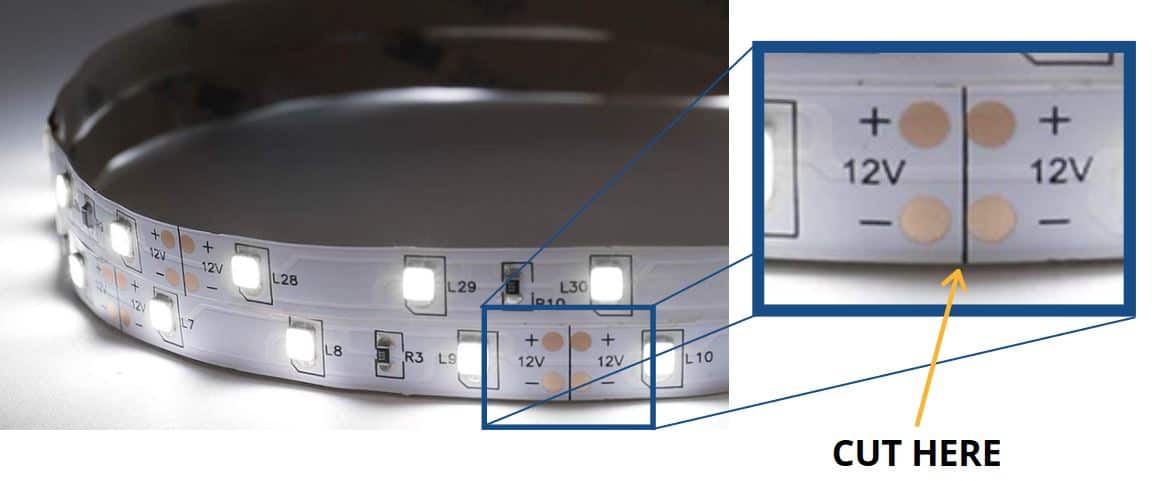Whether you’re looking to illuminate your kitchen cupboards or backlight your TV, with LED strip lights, there’s a solution to everything. Favored for their versatility, LED strips to consist of a series of LED emitters installed onto a narrow, flexible circuit board.
Yes, LED strip lights will carry on working after they’ve been cut as long as you cut along the designated lines. LED strips are made up of several individual circuits, so each cut line demarcates the end of one circuit and the start of a new one. Cutting elsewhere on the LED strip will cause that circuit, and potentially the whole strip, to cease working.
Cutting along a straight line sounds simple enough, right? You’d be surprised at how many people get it wrong and wreck perfectly good lights in the process.
Keep reading for an easy-to-follow guide on how to cut LED strip lights, reconnect two separate pieces, and what to do if it all goes wrong.
Can You Cut LED Strip Lights?
When it comes to LED strip lights, there is no ‘one size fits all.’ But whether you need lights that are flexible or rigid, monochromatic or RGB, waterproof or non-waterproof, most LED strips will have one thing in common… they can be cut to custom lengths.
At regular intervals throughout each LED strip will be straight or dotted black lines.
Circuits are entirely closed at these points, so these are the safest places to cut your LEDs without causing any damage.
At each side of the black cutting line there should be copper soldering pads that form a symmetrical looking pattern. Locating these copper pads is a handy tip for ensuring that you’ve identified the cutting line correctly.
How To Cut Strip Light Safely

Customizing the length of your LED strip lights is relatively straightforward. Here’s my, step-by-step guide.
Start by testing your lights to check that they work. This may seem obvious, but in most cases cutting or soldering lights will void your warranty, so it’s better to double-check.
Next, you’ll need to determine how long your LED strip needs to be. To do this, you should measure where you want the lights to go. Be as accurate as you can with this. Then you’ll choose the cutting line on your LED strip that’s closest to this length of measure.
Cut precisely along the cutting line with a sharp knife or pair of scissors. Take your time and remember that LED strips are designed to be cut, so you’re not going to get a shock.
Now you’ll need to decide how you’re going to connect the strip to the power source. Most reels come with a pre-fitted socket, but cutting down the LED strip gets rid of this, so you’ll need to fit a new one.
Strip connectors are generally the easiest solution as they don’t require any tools. Start by using a knife to cut away the translucent plastic covering the copper pads.
Then, just insert the strip into the connector, ensuring that the components match up e.g., green lines up with green.
The second method is to solder a socket directly to the strip using a soldering iron. Melt the solder directly onto the copper dots to form a small puddle and line up the polarity of the wires.
The black wire should line up with the negative mark, and the red line should line up with the positive mark.
Use wire strippers to strip around half an inch of casing off the end of your socket wires. Twist the end of the wire to join all the frayed ends and attach the wires to the solder puddles.
Once a connection has been established, you can plug your strip lights into a power source and check that they’re working. Voila! It’s that simple.

Can You Reconnect LED Strip That Has Been Cut Off?
What happens if you cut the strip too short? Can the two pieces be reconnected, or will you have to buy a new strip?
Provided that you cut along the designated cutting line, LED strips can be reconnected using the same method described above. Again, you can choose between soldering the two pieces back together, or using a solderless connector.
Connectors are readily available from retailers just like this set on Amazon, and they come in a range of different shapes, namely right angles, and T-tap.

Customizing the length of your LED strips may sound uncomplicated, but mistakes can happen.
If your LEDs aren’t working after being cut, check whether your lights were designed to be cut.
If they weren’t, but you still cut them anyway, then, unfortunately, the damage has been done. In these lights, the circuit runs continuously throughout the entire length, so cutting it will have caused permanent damage.
If your strip was designed to be cut, the second measure is to check you’ve cut in the right place.
Cutting outside of the cutting line will kill that individual circuit, so you’ll have to trim back to the closest cutting line.
Elsewhere, if your LED strip is working but is a different shade of brightness at each end, you’re experiencing a voltage drop.
Alternatively, if your RGB LED strips are not changing color, this suggests that you’ve lined the polarities up incorrectly. To ameliorate this, just flip your strip around and reconnect it.
Final Words
There you have it! LED strip lights can be customized to meet the requirements of any installation, no matter how big or small.
So it’s no wonder they’re swiftly becoming the most popular form of LED lighting.
If you’re still feeling unsure, it is possible to get LED strip lights cut by a professional, but if you follow my guide, I promise there is nothing to be scared of.
